|
|
|
| |
|
|
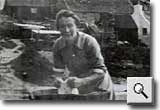 |
| Water
Supply |
| |
Margaret
Ingram is busy doing washing outside ‘Buckies’,
circa 1925. At that time the only way to get a supply
of fresh water was to carry it in a bucket, either
from one of the pumps situated at various points throughout
the village or from the Bog Wall in Low Town near
the foreshore.
To the rear of Margaret several of the houses that
were built on the Cliff are clearly visible. The white
house on the extreme right is the one in which T.E.
Lawrence stayed in 1930. Behind the houses is the
‘Rivie’, the promontory dividing Cransdale
from Collieston.
Margaret (nee Kidd) was born in 1867 and married Charles
Ingram in 1893. The couple had eleven children and
spent most of their married life in Collieston where
they lived in various houses in the village before
moving to Cluny Cottages near the Sand Loch in the
late 1920’s where they lived until they both
died in 1952. |
|
|
| |
|
|
| |
| A
group of people are fetching water from the pump,
near the entrance to Marine Cottage, in 1919. At this
time the only way to get a supply of fresh water was
to carry it in a bucket, either from one of the pumps
situated at various points throughout the village,
or from the Bog Wall in Low Town near the foreshore.
Towards the end of the 1920’s the Pumping
Station at Perthudden, built some 30 years previously,
was upgraded at the cost of £73.00. Water
was then pumped from an underground stream up to
a header tank at the top of the cliffs.
Many people in the village took advantage of this
modern technology and had taps and sinks installed
in their homes.
|
|
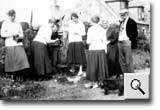 |
| |
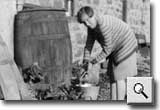 |
A
woman is filling a bucket with water from a water-barrel
circa 1920. Prior to the arrival of mains water to
the village the only way to get a supply of fresh
water into the house was by carrying it in a bucket.
Water had to be fetched from either the village pump
or from the underground spring at the Bog Wall. For
general household use such as hair washing, most families
had a water-barrel for collecting rainwater.
|
| |
|
|
| |
|
|
| |
Public Transport |
|
| |
| |
From
the early 1920's to the late 1940's Alex Ross, from
Newburgh, ran a bus service from Collieston to Aberdeen.
He would drive the bus to Aberdeen in the morning,
drive the bus back to Collieston again in the evening
and then motorcycle back to his home in Newburgh.
In addition to providing a much needed service for
the people of the village who worked and studied in
Aberdeen, the bus also served as a link between the
fishing community who had left Collieston in the early
part of the Twentieth Century to move to the Torry
area of Aberdeen, and the homes which many of them
still owned in the village.
In early summer Alex would drive his bus over to Torry,
load furniture onto the roof rack of the bus and drive
the families and their belongings back to their homes
in Collieston where they would spend their summer
holidays. Alex eventually sold the bus service to
Sutherlands of Peterhead. |
|
| |
|
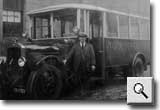 |
| |
|
|
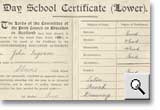 |
| Education |
| |
A copy
of the Day School Certificate awarded to John (Jack)
Ingram in 1926. Jack left Slains School when he was
14 years old. Born at No 22 Collieston in 1912, Jack
was the second youngest of eleven children born to
Charles Ingram, a salmon fisherman, and his wife Margaret.
The Ingram family moved to Cluny Cottages, one of
the former Coastguard Cottages, in 1929. After leaving
school Jack was ‘fee’d’ at several
local farms before studying to become a psychiatric
nurse.
Jack and his wife, Jessie, also a psychiatric nurse,
worked at a hospital in Perthshire until retiring
in 1970 and moving back to Collieston.
|
|
|
| |
|
|
| |
Slains
Schoolhouse, viewed from the south, near the main
Newburgh-Cruden Bay road circa 1920. The house was
home to the Head Teachers of Slains School until the
1980’s, when it was sold as a private dwelling,
soon after the retirement of Mr Emslie.
Slains School is clearly visible to the rear of the
schoolhouse. In the 1960’s a new school was
built to cater for the growing number of children
living in the area and the old school was demolished
in 1968. The land occupied by the old school was subsequently
turned into a playground for the pupils.
|
|
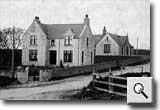 |
| |
| |
|
|
 |
| Fishwife |
| |
A fishwife
called Maggie Ross circa 1925 dressed in clothes typically
worn by the women residents of the village at that
time. The hardwearing leather boots and woollen stockings
were required to keep her feet warm and dry and protected
from the rough roads.
The skirt, jacket and headscarf were woollen and would
have helped keep the cold, north winds at bay. On
her back can be seen the creel which would have been
filled with fish and carried round the countryside
where she would have either sold her fish or used
them as barter for meat and eggs.
To keep the farm produce separate from the fish, she
would have carried a separate basket.
|
| |
|
|
| |
|
|
| |
|
|
| |
| Spelding
Teas |
| |
The Collieston
Tearoom was very popular with visitors to the village
during the 1920’s and 30’s. It was situated
on the Brae Head next to the village bakery and, for
the princely sum of one shilling and sixpence per
person, a mouth watering afternoon tea was provided.
The waitress, smartly dressed in black with a white
apron and frill, would bring the purchaser one of
Collieston’s famous Spelding Teas consisting
of oatcakes and butter, speldings, home made cakes
and a pot of tea. |
| |
|
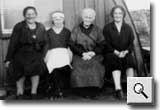 |
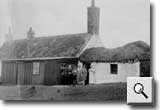 |
The
bakery with Mr A Walker as proprietor, provided the
villagers with their daily supply of freshly
baked
big plain loaves and mouth watering shortbread, baked
to Mrs Stock’s recipe.
During the summer months of the 1920’s, visitors
flocked to the bakery’s Tearoom to partake of
the famous Spelding Teas which consisted of oatcakes,
butter, grilled speldings, tea and cakes, all for
the princely sum of one shilling and sixpence.
|
| |
|
|
| |
|
|
| |
| Speldings |
| |
Circa
1925, the Tea Room, which was located in the High
Town area of the village in the house now known as
the Bakery. It’s popularity was based largely
on the ‘Spelding Teas’ that helped to
attract visitors to the village. People also used
to buy speldings to take away.
The building is a single storey rubble and harled
cottage with a turf roof and wooden extensions. A
feature of the building is the very high chimney which
would have created extra up draught for the bakery
oven.
The proprietor, A Walker, is standing outside the
tearoom, posing for the camera, and is wearing a white
apron.
|
| |
|
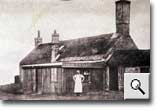 |
|
 |
|
| ....copyright
collieston's century 2003 |
|